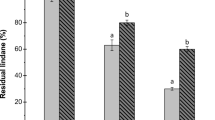Abstract.
Isolation by a dilution plate method from Pb-polluted soil samples allowed us to select a Pb-resistant strain of Paecilomyces lilacinus, which was able to grow in media containing up to 1,437 mg Pb l–1. Tests on the actual Pb availability in amended culture media indicate that medium components bind most of the added Pb (71–98.5%, depending on the amount added and on the pH reached). Sorption of Pb by dead and living biomasses of P. lilacinus was studied; the metal binding followed a two-stage process, with a very rapid surface adsorption within the first 6 h, and a slow intracellular diffusion in living cells in the 42 following hours.
Similar content being viewed by others
Author information
Authors and Affiliations
Additional information
Electronic Publication
Rights and permissions
About this article
Cite this article
Zucconi, L., Ripa, C., Alianiello, F. et al. Lead resistance, sorption and accumulation in a Paecilomyces lilacinus strain. Biol Fertil Soils 37, 17–22 (2003). https://doi.org/10.1007/s00374-002-0555-4
Received:
Accepted:
Issue Date:
DOI: https://doi.org/10.1007/s00374-002-0555-4




